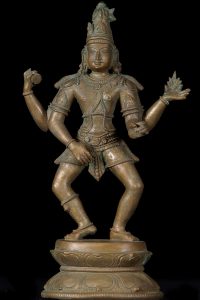
Although Hindu God Shiva is most often depicted in human like form, the worship of Shiva as lingam or linga is also a very important practice within Hindu society. Shiva is often worshiped in the form of a vertical rounded column. Within Hinduism linga means symbol while Shiva is thought to be one who is all knowing. Therefore, Shivalinga stands as a symbol for the great God of the universe who is all-auspicious.
Within the Shivalinga Hindus believe lays all the knowledge of the universe. Since hindus believe one god creates, sustains, and draws back the universe the Shivalinga is a symbol of God himself. This symbolism was brought to life in the Vedas where devotees sung praise to a sacrificial post.

This Lingam is used for worship in temples throughout the world. Many debate whether the lingam is actually a symbol of the actual body of Shiva himself, or simply as a spiritual metaphor for the all-knowing God. Most Hindus believe it is a source of divine energy, and give offerings to the linga in their temples. The Lingam is said to be a limitless and endless pillar symbolizing the infinite.
